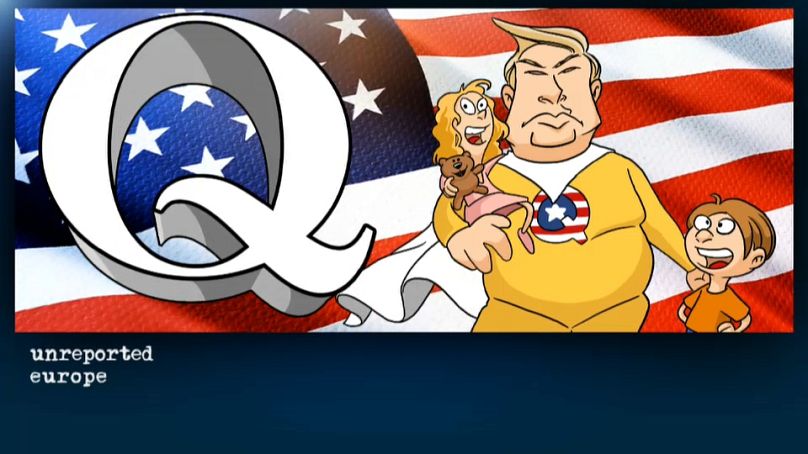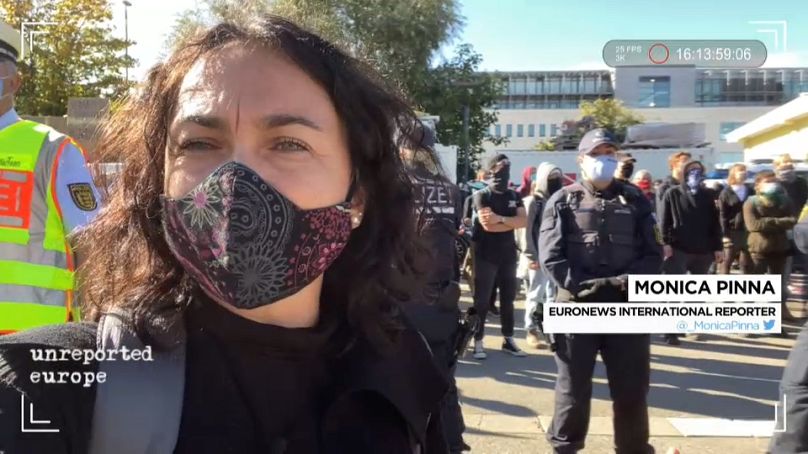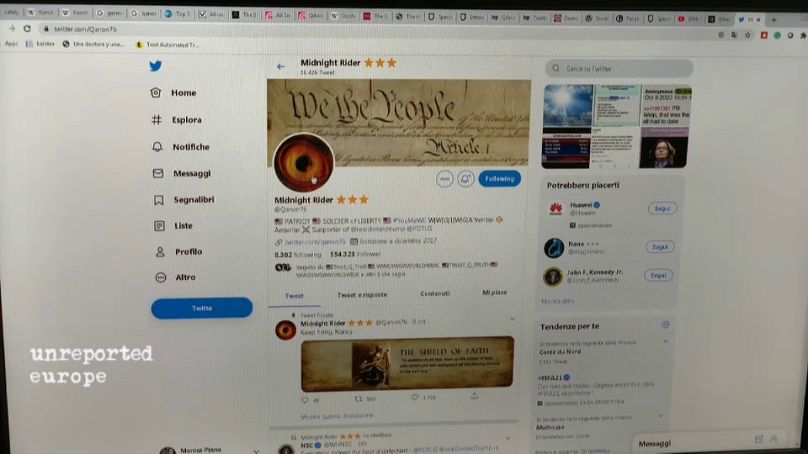
A Satan-worshipping paedophile ring led by prominent Democrats who are allegedly kidnapping, abusing and eating children – as well as and drinking their blood in an attempt to live forever.
President Donald Trump is battling this evil group, leading to a day of reckoning involving the mass arrest of politicians and public figures among them George Soros, Bill Gates, Tom Hanks and Oprah Winfrey.

This outlandish scenario, clearly not factually-based, is the theory behind QAnon, one of the most bizarre conspiracy theories of modern times. It originated online in the United States and quickly crossed into the real world. It has now gone global, spreading in Europe and boosted by the Covid-19 pandemic.
QAnon placards featuring the now-infamous Q symbol first appeared in Europe during demonstrations against Coronavirus restrictions in Berlin, London and Paris.
In Berlin in August, far right extremists waved QAnon banners and flags of the German Reich of 1871-1918 as they attempted to storm Germany’s parliament building.
Earlier this month, I reported from a major demonstration in the German city of Konstanz. where protesters gathered against government measures to contain the pandemic; it attracted groups of all political hues.
While the ban on displaying the more recognised symbols of extremism was observed, Qanon’s theories – and symbols – were far from absent.
One protester told me that the German government was trying to divide people by introducing the measures:
“I find there is huge control (by) the state. I stand here for all people, also for QAnon, because QAnon also says we are being divided more and more.
“I pray for every person who manages to get away from the mainstream, I also want more people to wake up!

Researchers studying conspiracy theories say the pandemic has acted as a catalyst in boosting the popularity of QAnon, due to the uncertainty brought by COVID-19 – and by QAnon’s nebulous, insidious nature.
Chine Labbe is EU Managing Editor for NewsGuard – an organisation rating the trustworthiness of information websites and which has published a detailed report on the QAnon phenomenon in Europe.
Labbe says the QAnon theory is flexible enough to be interpreted and tailored by the individual:
“It’s sort of a meta-conspiracy and it encompasses a lot of different ideas, theories that are very easily translatable.
“The idea that you have this Deep State being led by world elites and working against the saviours, represented by a few white hats in the world with Donald Trump and others, it’s so easy to translate.
“For the French, it will involve Macron being described as a pawn of the Deep State.
“For the Germans, it will be Merkel who’s a puppet of the Deep State.”
This vagueness, this plasticity, is how QAnon has attracted people across Europe with different ideologies – who can then pick and choose from a wide range of narratives. Some are anti-establishment, others are anti-vaccine. The basis behind the anti-COVID demonstrations and a belief in conspiracies partially overlap.
Other people that I spoke to in Konstanz told me they felt they were being manipulated and deliberately frightened, or that they were being ‘muzzled’ by COVID measures that they considered to be completely excessive.
Although QAnon has now crossed over into the real world, with people on the ground at demonstrations in Europe, social media first nurtured it. The number of QAnon-related Tweets rose from 5 million in 2017 to 12 million worldwide this year, with Germany ranking 5th and the UK second just behind the US.
Chine Labbe says the increase was dramatic:
“We identified about 450,000 followers across Europe on QAnon-specific accounts, groups, pages on social media and websites.
“In Europe it only started in late 2019, early 2020 and in just a few months, it’s managed to amass an impressive amount of followers.”
QAnon stands for Q-Anonymous, where Q might be someone in the Trump administration, or a military intelligence figure, or perhaps a high security officer with a Q clearance – the highest level of security clearance as required by the US Department of Energy, to access top-secret information on nuclear weapons.

Many social media platforms have taken measures against the spread of QAnon; Twitter banned 7,000 of the most virulent accounts, but over 93,000 still remain active.
Facebook recently took down QAnon-themed groups and pages as well as Instagram accounts that reference QAnon, but another platform has gained relevance: Telegram, a text, video and voice messaging system with end-to-end encryption, enabling secret communication.
The ISD thinktank recently published a report concluding that Telegram has become “a safe space for white supremacists to share and discuss a range of explicit extremist material” and a “permissive environment where overt calls for violence and support for terrorism is widespread”.
Disinformation and misinformation are at the core of QAnon’s communication techniques. It spreads no verifiable facts, sources or quotes. We found telling examples in Konstanz, although most participants in the protest were not self-declared QAnon supporters.
One man I spoke to said he was a doctor – and his views were “proven medicine”. He refused to wear a mask and said that they killed children. Although he admitted this was unproven, he said it was “close to proven.”
German police have denied one of the claimed deaths and also said there is no evidence to support the suggestion that any other children have died from wearing masks.
Another man I spoke to, dressed as a caveman, said people should not wear masks “but they have to have a strong immune system” which they could ensure by taking Vitamin D3.
I asked him if he was a doctor:
“No, I’m not a doctor, I’m an auto-mechanic. People who have Vitamin D3 don’t die.
“The other people die. 98.9%. It’s a study from the Daily Mail (a British tabloid newspaper)”.

The FBI has identified QAnon as a domestic terrorist threat; in the US, the movement has been linked to a killing, a separate armed stand-off and also to several arrests. In Europe, its supporters tend to come from the far right, especially in Germany.
Pia Lamberty, a German social psychologist potentially sheds light on QAnon’s success by suggesting people’s self-esteem can be boosted by believing in conspiracy theories:
“You can feel unique by spreading conspiracy. You are the person who sees the truth.
“The others are all naïve, or part of the system or part of the conspiracy itself.
“In Germany, there’s one term that’s very widespread, it’s called ‘sleeping sheep’ and this is how these people call those who are not believing in the conspiracy.
“The belief in conspiracy theories can lead to violence, it can be a radicalisation multiplier.
“We know from Germany that 25% of those who have this abstract conspiracy mentality say that they would use violence to fulfil their goals.”
QAnon has become mainstream in the United States and is openly supported by over 20 Republican candidates running for Congress. President Trump has not distanced himself from the movement, even days before the presidential election.
